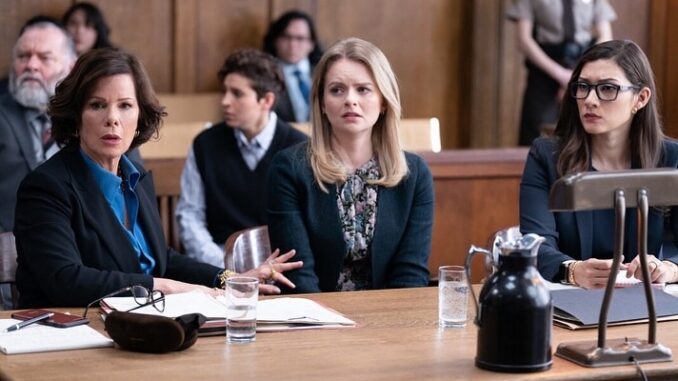
The television landscape is a treacherous sea, where even shows seemingly charting a steady course can suddenly encounter an unforeseen storm and be pulled under. Such was the fate of CBS's charming legal dramedy, So Help Me Todd. With its delightful blend of wit, heartwarming family dynamics, and engaging procedural elements, starring the magnetic duo of Marcia Gay Harden and Skylar Astin, the show had carved out a loyal niche. Its cancellation after two seasons, therefore, sent ripples of confusion and frustration through its fanbase, illuminating the opaque and often brutal realities of network television in the streaming era. The decision wasn't merely a roll of the dice; it was a complex interplay of internal CBS calculus and the evolving metrics of success, ultimately clashing with passionate fan investment.
At the heart of CBS's decision, as with any broadcast network, lies a multi-faceted financial equation. While So Help Me Todd enjoyed a solid critical reception and a dedicated following, its performance was likely evaluated through several lenses, some traditional, some modern. The paramount concern for a linear network remains live-plus-same-day and live-plus-seven-day viewership, particularly within advertiser-coveted demographics (like adults 18-49 or 25-54). While Todd consistently pulled respectable numbers, often benefiting from its lead-in (Young Sheldon in its first season), it never quite broke out into the blockbuster category that secures a show's future unequivocally. It was "good," but perhaps not "great enough" in the eyes of executives constantly seeking the next NCIS or Ghosts. Every slot on the primetime schedule is valuable real estate, and if a show isn't delivering top-tier ad revenue or demonstrating significant growth potential, it becomes vulnerable, regardless of its charm.
Furthermore, the economics of television production are brutal. So Help Me Todd, like any hour-long drama, carries substantial production costs, including cast salaries, crew, locations, and post-production. While CBS Studios produced the show, making it an "in-house" product that theoretically benefits the parent company (Paramount Global) through streaming rights on Paramount+ and international sales, this doesn't guarantee indefinite life. The cost-to-benefit ratio is constantly under scrutiny. Even if a show performs decently on streaming, the ad revenue from linear viewership remains the primary driver for a broadcast network. If Todd's linear ad sales weren't robust enough to justify its production budget when balanced against the network's overall programming strategy and the performance of newer pilots, it faced an uphill battle. Networks are always developing new shows, and if a promising new pilot tests well and offers perceived higher upside, existing shows, even beloved ones, can be sacrificed to make room. This is the constant, high-stakes chess game played in the labyrinthine corridors of network television.
The fan backlash, on the other hand, stemmed from a profoundly different perspective: one of emotional investment and a sense of perceived injustice. Viewers had fallen in love with the witty banter between Margaret (Harden) and Todd (Astin), the quirky supporting characters, and the comfort of its weekly escapism. For many, So Help Me Todd was a reliable "comfort watch" – intelligent, funny, and consistently entertaining. The show had been renewed for a second season, indicating initial confidence from CBS, which made the sudden axe feel particularly jarring and arbitrary. Fans expressed their visceral disappointment across social media platforms, organizing petitions, and flooding comment sections with pleas for a reversal or a save from another platform.
This passionate outcry highlighted a growing frustration among viewers: the feeling that good, solid shows are being canceled prematurely, often leaving cliffhangers unresolved and character arcs incomplete. In an era where streaming platforms promise full seasons and binge-watching, the traditional network model's reliance on stringent, often opaque metrics can feel antiquated and frustratingly impersonal to the audience. For fans, So Help Me Todd wasn't just a product; it was a weekly appointment, a source of joy. Its cancellation felt like a personal slight, a dismissal of their loyalty and enjoyment in favor of cold, corporate numbers they couldn't comprehend or influence.
In essence, the cancellation of So Help Me Todd serves as a poignant microcosm of the ongoing tension within the television industry. On one side stands the traditional broadcast network, grappling with declining linear viewership, the shifting sands of advertising revenue, and the constant need to refresh its lineup with potentially higher-performing shows. On the other side stands the devoted fanbase, frustrated by the unceremonious removal of a show they cherished, caught in the crossfire of business decisions they have no part in. So Help Me Todd's abrupt departure, despite its merits and loyal following, is a stark reminder that in the high-stakes world of television, charm and quality alone are often not enough to guarantee survival; they must align perfectly with an ever-evolving and often unforgiving financial calculus. And for the fans left behind, it's a bittersweet testament to the power of television to connect and disappoint, often in the same breath.
